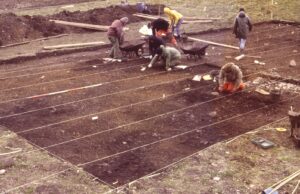
My introduction to archaeology was very much through the joy of being out of doors. Exploration, hard work – often in bad weather, fellowship and friendship. Some of the people I met on digs in the 1970s are still friends today. It was wonderful. But archaeology is not all about the excitement of sunshine and rain.
Despite the stereotypical image of the digger in work clothes and wellies, archaeology is not just about excavation. Most archaeologists spend more time indoors than out in the field. Much work is done alone, or in small groups, sitting at a desk, or in a laboratory (learn about the science side here). This, of course, has never been more so than today, when communal work of any sort is difficult. The archaeological data that we all seek to research exists in the flesh – whether as a site, artefact, or microfossil. But there are ways to approach it remotely. Just now necessity forces us to develop the application of remote archaeology.
Some of it is not so strange. Online libraries and archives already play a central role in desktop research in which existing data is amassed and previous reports read. Databases like Canmore, Pastmap and the local Historic Environment Records provide a wealth of information and are easy to consult. Many publishers and libraries have enhanced access to their collections during lockdown. Access to the billiant SCRAN archive is free until the end of July 2020, and it is well worth browsing the material online at any time. The Society of Antiquaries of London have compiled a brilliant list of resources. Lectures and courses can be recorded and made available over the internet to people around the globe and in any time zone. There has been a floruit of online lecturing and web-courses – never have the possibilities to improve your archaeological understanding been so great. There are even online conferences, most of which offer free registration, providing access to cutting edge research and debate between leading specialists. It is a wonderful opportunity for those with limited funds or ability to travel.
Some products develop existing applications and take them further than we had once thought commonplace. Museums have enhanced the virtual tours of their collections and many have switched their summer exhibitions to online exhibitions. There are fantastic offerings, all with in depth and informative commentary. Some have even responded (admirably rapidly I must say) to the current situation to theme their summer offerings – have a look at the University of Aberdeen students’ exhibition: Safekeeping. How better to interrogate the detail of artefacts and access expert information without succumbing to ‘museum feet’? It goes further than that. Bodies such as Open Virtual Worlds (a research group at the University of St Andrews), now offer virtual tours of reconstructed buildings and environments. From the comfort of home it is possible to not just to visit remote places, but also to indulge in some time travel and learn about the results of research while you are at it.
And, the research goes on. Never have techniques of remote sensing been so popular! It is a reminder that archaeology does not have to be about the destruction that inevitably arises from an excavation (it is the ultimate irony of being an archaeologist that we end up destroying the sites that we love). There are many ways in which it is possible to ‘see’ below the ground surface and record information about the archaeological material that lies buried there. Work using high resolution ground penetrating radar at the city of Falerii Novi in Italy has revealed astonishing detail of the buildings across a wide area. In Mexico, LiDAR laser technology has enabled archaeologists to use aerial survey to investigate ancient Maya remains.
Closer to home, Archaeology on Furlough has provided those with unexpected time on their hands with an opportunity to learn new skills, undertake research, and make new colleagues – all from the comfort of their own homes. It is an important way to maintain your identity as an archaeologist, and even to build professional qualifications by logging your work for CPD. Projects range widely from the investigation of ancient extinctions to agriculture and design. The results may not be quite the research outputs that we expected from 2020 but they will be just as significant. Elsewhere, individual university departments have recruited volunteers to assist citizen science projects and the results are already making the news. In Scotland the DigIt group have been compiling some online excavation alternatives, as well as keeping people up to date with excavation news as soon as conditions ease. You can travel in both time and space (from the comfort of your armchair) with HEIR, and help out by identifying locations and sites and helping to record change.
While our living restrictions may be easing, life is going to be very different for a long time and it may be months, if not longer, before we can feel as relaxed about travel and mixing with others as we did before. There is no need to feel left out, however. It is still possible to engage, even to become part of a team.
The 2020 covid-19 lockdown has been a difficult time for all. It is acutely felt by any profession that relies on fieldwork for data. That archaeology has been able to redefine the nature of that fieldwork, and to do so in a way that continues to advance the profession with positive results, is, surely, a demonstration of the way in which we live not only in the past, but also in the future.
NB: the links above are just examples of many, many that you can explore – have some fun trawling the web!
You must be logged in to post a comment.